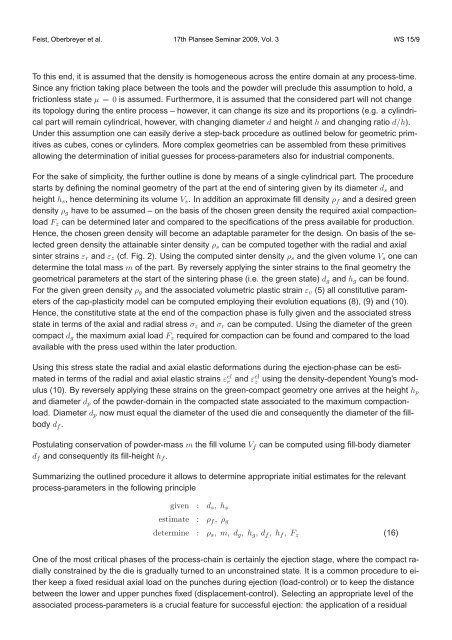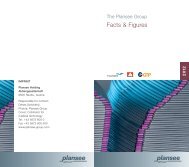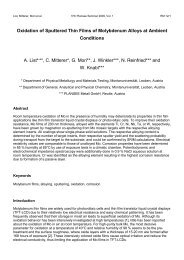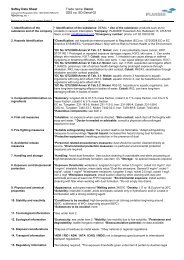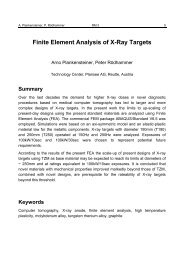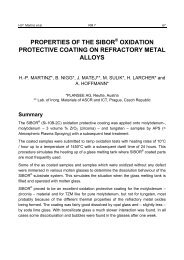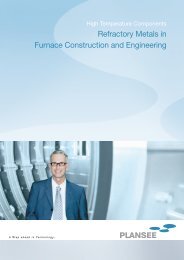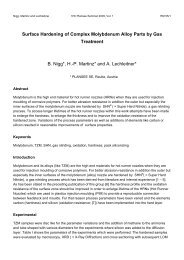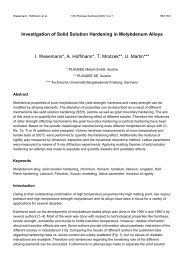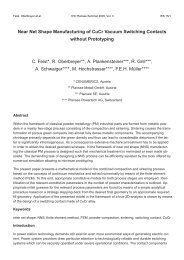Near Net Shape Manufacturing of CuCr Vacuum Switching Contacts ...
Near Net Shape Manufacturing of CuCr Vacuum Switching Contacts ...
Near Net Shape Manufacturing of CuCr Vacuum Switching Contacts ...
You also want an ePaper? Increase the reach of your titles
YUMPU automatically turns print PDFs into web optimized ePapers that Google loves.
Feist, Oberbreyer et al. 17th Plansee Seminar 2009, Vol. 3 WS 15/9<br />
To this end, it is assumed that the density is homogeneous across the entire domain at any process-time.<br />
Since any friction taking place between the tools and the powder will preclude this assumption to hold, a<br />
frictionless state µ = 0 is assumed. Furthermore, it is assumed that the considered part will not change<br />
its topology during the entire process – however, it can change its size and its proportions (e.g. a cylindrical<br />
part will remain cylindrical, however, with changing diameter d and height h and changing ratio d/h).<br />
Under this assumption one can easily derive a step-back procedure as outlined below for geometric primitives<br />
as cubes, cones or cylinders. More complex geometries can be assembled from these primitives<br />
allowing the determination <strong>of</strong> initial guesses for process-parameters also for industrial components.<br />
For the sake <strong>of</strong> simplicity, the further outline is done by means <strong>of</strong> a single cylindrical part. The procedure<br />
starts by defining the nominal geometry <strong>of</strong> the part at the end <strong>of</strong> sintering given by its diameter ds and<br />
height hs, hence determining its volume Vs. In addition an approximate fill density ρf and a desired green<br />
density ρg have to be assumed – on the basis <strong>of</strong> the chosen green density the required axial compactionload<br />
Fz can be determined later and compared to the specifications <strong>of</strong> the press available for production.<br />
Hence, the chosen green density will become an adaptable parameter for the design. On basis <strong>of</strong> the selected<br />
green density the attainable sinter density ρs can be computed together with the radial and axial<br />
sinter strains εr and εz (cf. Fig. 2). Using the computed sinter density ρs and the given volume Vs one can<br />
determine the total mass m <strong>of</strong> the part. By reversely applying the sinter strains to the final geometry the<br />
geometrical parameters at the start <strong>of</strong> the sintering phase (i.e. the green state) dg and hg can be found.<br />
For the given green density ρg and the associated volumetric plastic strain εv (5) all constitutive parameters<br />
<strong>of</strong> the cap-plasticity model can be computed employing their evolution equations (8), (9) and (10).<br />
Hence, the constitutive state at the end <strong>of</strong> the compaction phase is fully given and the associated stress<br />
state in terms <strong>of</strong> the axial and radial stress σz and σr can be computed. Using the diameter <strong>of</strong> the green<br />
compact dg the maximum axial load Fz required for compaction can be found and compared to the load<br />
available with the press used within the later production.<br />
Using this stress state the radial and axial elastic deformations during the ejection-phase can be esti-<br />
mated in terms <strong>of</strong> the radial and axial elastic strains ε el<br />
r and ε el<br />
z using the density-dependent Young’s modulus<br />
(10). By reversely applying these strains on the green-compact geometry one arrives at the height hp<br />
and diameter dp <strong>of</strong> the powder-domain in the compacted state associated to the maximum compactionload.<br />
Diameter dp now must equal the diameter <strong>of</strong> the used die and consequently the diameter <strong>of</strong> the fillbody<br />
df .<br />
Postulating conservation <strong>of</strong> powder-mass m the fill volume Vf can be computed using fill-body diameter<br />
df and consequently its fill-height hf .<br />
Summarizing the outlined procedure it allows to determine appropriate initial estimates for the relevant<br />
process-parameters in the following principle<br />
given : ds, hs<br />
estimate : ρf, ρg<br />
determine : ρs, m, dg, hg, df, hf, Fz<br />
One <strong>of</strong> the most critical phases <strong>of</strong> the process-chain is certainly the ejection stage, where the compact radially<br />
constrained by the die is gradually turned to an unconstrained state. It is a common procedure to either<br />
keep a fixed residual axial load on the punches during ejection (load-control) or to keep the distance<br />
between the lower and upper punches fixed (displacement-control). Selecting an appropriate level <strong>of</strong> the<br />
associated process-parameters is a crucial feature for successful ejection: the application <strong>of</strong> a residual<br />
(16)


